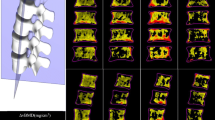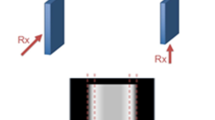Abstract
Summary
A case-control study assessing the association of DXA-derived 3D measurements at lumbar spine with osteoporotic hip fractures was performed. Stronger association was found between transcervical hip fractures and integral (AUC = 0.726), and cortical (AUC = 0.696) measurements at the lumbar spine compared with measurements at the trabecular bone (AUC = 0.617); although femur areal bone mineral density (aBMD) remains the referent measurement for hip fracture risk evaluation (AUC = 0.838).
Purpose
The aim of the present study was to evaluate the association between DXA-derived 3D measurements at lumbar spine and osteoporotic hip fractures.
Methods
We analyzed a case-control database composed by 61 women with transcervical hip fractures and 61 age-matched women without any type of fracture. DXA scans at lumbar spine were acquired, and areal bone mineral density (aBMD) was measured. Integral, trabecular and cortical volumetric BMD (vBMD), cortical thickness, and cortical surface BMD (sBMD) at different regions of interest were assessed using a DXA-based 3D modeling software. Descriptive statistics, tests of difference, odds ratio (OR), and area under the receiver operating curve (AUC) were used to compare hip fracture and control groups.
Results
Integral vBMD, cortical vBMD, cortical sBMD, and cortical thickness were the DXA-derived 3D measurements at lumbar spine that showed the stronger association with transcervical hip fractures, with AUCs in the range of 0.685–0.726, against 0.670 for aBMD. The highest AUC (0.726) and OR (2.610) at the lumbar spine were found for integral vBMD at the posterior vertebral elements. Significantly, lower AUC (0.617) and OR (1.607) were found for trabecular vBMD at the vertebral body. Overall, total femur aBMD remains the DXA-derived measurement showing the highest AUC (0.838) and OR (6.240).
Conclusion
This study showed the association of DXA-derived measurements at lumbar spine with transcervical hip fractures. A strong association between vBMD at the posterior vertebral elements and transcervical hip fractures was observed, probably because of global deterioration of the cortical bone. Further studies should be carried out to investigate on the relative risk of transcervical fracture in patients with long-term cortical structural deterioration.



Similar content being viewed by others
References
Consensus Development Conference (1991) Diagnosis, prophylaxis, and treatment of osteoporosis. Am J Med 90:107–110. https://doi.org/10.1016/0002-9343(93)90218-E
Kanis JA, WHO Scientific Group (2007) Assesment of osteoporosis at the primary health care level. Technical report
Hernlund E, Svedbom A, Ivergård M, Compston J, Cooper C, Stenmark J, McCloskey E, Jönsson B, Kanis JA (2013) Osteoporosis in the European Union: medical management, epidemiology and economic burden: A report prepared in collaboration with the International Osteoporosis Foundation (IOF) and the European Federation of Pharmaceutical Industry Associations (EFPIA). Arch Osteoporos 8:136. https://doi.org/10.1007/s11657-013-0136-1
Kanis JA (2002) Diagnosis of osteoporosis and assessment of fracture risk. Lancet 359:1929–1936. https://doi.org/10.1016/S0140-6736(02)08761-5
Siris ES, Chen Y-T, Abbott TA, Barrett-Connor E, Miller PD, Wehren LE, Berger ML (2004) Bone mineral density thresholds for pharmacological intervention to prevent fractures. Arch Intern Med 164:1108–1112. https://doi.org/10.1001/archinte.164.10.1108
Silva BC, Broy SB, Boutroy S et al (2015) Fracture risk prediction by non-BMD DXA measures: the 2015 ISCD official positions part 2: trabecular bone score. J Clin Densitom 18:309–330. https://doi.org/10.1016/j.jocd.2015.06.008
Bauer JS, Link TM (2009) Advances in osteoporosis imaging. Eur J Radiol 71:440–449. https://doi.org/10.1016/j.ejrad.2008.04.064
NIH Consensus Development Panel on Osteoporosis Prevention (2001) Osteoporosis: prevention, diagnosis, and management. Am J Med 285:785–795. https://doi.org/10.1016/S0002-9343(97)00415-4
Li N, Li XM, Xu L et al (2013) Comparison of QCT and DXA: osteoporosis detection rates in postmenopausal women. Int J Endocrinol 2013. https://doi.org/10.1155/2013/895474
Engelke K, Libanati C, Fuerst T et al (2013) Advanced CT based in vivo methods for the assessment of bone density, structure, and strength. Curr Osteoporos Rep 11:246–255. https://doi.org/10.1007/s11914-013-0147-2
Therkildsen J, Winther S, Nissen L et al (2019) Feasibility of opportunistic screening for low thoracic bone mineral density in patients referred for routine cardiac CT. J Clin Densitom. https://doi.org/10.1016/j.jocd.2018.12.002
Perreir-Cornet J, Omorou AY, Fauny M et al (2019) Opportunistic screening for osteoporosis using thoraco-abdomino-pelvic CT-scan assessing the vertebral density in rheumatoid arthritis patients. Osteoporos Int
Ahmad O, Ramamurthi K, Wilson KE et al (2010) Volumetric DXA (VXA): a new method to extract 3D information from multiple in vivo DXA images. J Bone Miner Res 25:2744–2751. https://doi.org/10.1002/jbmr.140
Whitmarsh T, Humbert L, Del Río Barquero LM et al (2013) 3D reconstruction of the lumbar vertebrae from anteroposterior and lateral dual-energy X-ray absorptiometry. Med Image Anal 17:475–487. https://doi.org/10.1016/j.media.2013.02.002
Väänänen SP, Grassi L, Flivik G, Jurvelin JS, Isaksson H (2015) Generation of 3D shape, density, cortical thickness and finite element mesh of proximal femur from a DXA image. Med Image Anal 24:125–134. https://doi.org/10.1016/j.media.2015.06.001
Humbert L, Martelli Y, Fonolla R, Steghofer M, di Gregorio S, Malouf J, Romera J, Barquero LM (2017) 3D-DXA: assessing the femoral shape, the trabecular macrostructure and the cortex in 3D from DXA images. IEEE Trans Med Imaging 36:27–39. https://doi.org/10.1109/TMI.2016.2593346
López Picazo M, Magallón Baro A, del Rio Barquero LM et al (2018) 3D subject-specific shape and density estimation of the lumbar spine from a single anteroposterior DXA image including assessment of cortical and trabecular bone. IEEE Trans Med Imaging 37:1–12. https://doi.org/10.1109/TMI.2018.2845909
López Picazo M, Humbert L, Di Gregorio S et al (2019) Discrimination of osteoporosis-related vertebral fractures by DXA-derived 3D measurements: a retrospective case-control study. Osteoporos Int 30:1099–1110. https://doi.org/10.1007/s00198-019-04894-y
Kanis JA, Johansson H, Oden A, McCloskey EV (2009) Assessment of fracture risk. Eur J Radiol 71:392–397. https://doi.org/10.1016/j.ejrad.2008.04.061
Marshall D, Wedel H (1996) Meta-analysis of how well measures of bone mineral density predict occurrence of osteoporotic fractures. BMJ 312:1254–1259. https://doi.org/10.1136/bmj.312.7041.1254
Cummings SR, Browner WS, Cauley JA et al (1993) Bone density at various sites for prediction of hip fractures. Lancet 341:72–75. https://doi.org/10.1016/0140-6736(93)92555-8
Melton LJ, Atkinson EJ, O’Fallon WM et al (1993) Long-term fracture prediction by bone mineral assessed at different skeletal sites. J Bone Miner Res 8:1227–1233. https://doi.org/10.1002/jbmr.5650081010
Stone KL, Seeley DG, Lui L et al (2003) BMD at multiple sites and risk of fracture of multiple types: long-term results from the study of osteoporotic fractures. J Bone Miner Res 18
Vega E, Mautalen C, Gomez H et al (1991) Bone mineral density in patients with cervical and trochanteric fractures of the proximal femur. Osteoporos Int 1:81–86
Kröger H, Lunt M, Reeve J et al (1999) Bone density reduction in various measurement sites in men and women with osteoporotic fractures of spine and hip: the European quantitation of osteoporosis study. Calcif Tissue Int 64:191–199. https://doi.org/10.1007/s002239900601
Chalhoub D, Orwoll ES, Cawthon PM, Ensrud KE, Boudreau R, Greenspan S, Newman AB, Zmuda J, Bauer D, Cummings S, Cauley JA, Osteoporotic Fractures in Men (MrOS) Study Research Group (2016) Areal and volumetric bone mineral density and risk of multiple types of fracture in older men. Bone 92:100–106. https://doi.org/10.1016/j.bone.2016.08.014
Heneghan JP, Kirke PN, Murphy BL, Darcy E, Daly L, Bourke GJ, Dinn E, Masterson J (1997) Evaluation of quantitative CT vertebral bone mineral density measurement and the Singh index in elderly females with hip fractures--a case control study. Br J Radiol 70:923–928. https://doi.org/10.1259/bjr.70.837.9486068
Lang TF, Augat P, Lane NE, Genant HK (1998) Trochanteric hip fracture: strong association with spinal trabecular bone mineral density measured with quantitative CT. Radiology 209:525–530. https://doi.org/10.1148/radiology.209.2.9807584
Lee SJ, Anderson PA, Pickhardt PJ (2017) Predicting future hip fractures on routine abdominal CT using opportunistic osteoporosis screening measures: a matched case-control study. Am J Roentgenol 209:395–402. https://doi.org/10.2214/AJR.17.17820
Schwartz S, Ort P (1986) Trabecular mineral content of the spine in women with hip fracture. Musculoskelet Radiol 159:737–740
Humbert L, Hazrati Marangalou J, Del Río Barquero LM et al (2016) Technical note: cortical thickness and density estimation from clinical CT using a prior thickness-density relationship. Med Phys 43:1945–1954. https://doi.org/10.1118/1.4944501
Yang L, Udall WJM, McCloskey EV, Eastell R (2014) Distribution of bone density and cortical thickness in the proximal femur and their association with hip fracture in postmenopausal women: a quantitative computed tomography study. Osteoporos Int 25:251–263. https://doi.org/10.1007/s00198-013-2401-y
Holzer G, Von Skrbensky G, Holzer LA, Pichl W (2009) Hip fractures and the contribution of cortical versus trabecular bone to femoral neck strength. J Bone Miner Res 24:468–474. https://doi.org/10.1359/jbmr.081108
Crabtree N, Loveridge N, Parker M, Rushton N, Power J, Bell KL, Beck TJ, Reeve J (2001) Intracapsular hip fracture and the region-specific loss of cortical bone: analysis by peripheral quantitative computed tomography. J Bone Miner Res 16:1318–1328. https://doi.org/10.1359/jbmr.2001.16.7.1318
Iorio JA, Jakoi AM, Singla A (2016) Biomechanics of degenerative spinal disorders. Asian Spine J 10:377–384. https://doi.org/10.1111/j.1365-3024.1991.tb00288.x
Adams MA (2009) Degenerative disc and vertebral disease - basic sciences. Surgery 27:297–300. https://doi.org/10.1016/j.mpsur.2009.03.005
Poole KES, Treece GM, Mayhew PM et al (2012) Cortical thickness mapping to identify focal osteoporosis in patients with hip fracture. PLoS One 7:1–7. https://doi.org/10.1371/journal.pone.0038466
Treece GM, Gee AH, Tonkin C, Ewing SK, Cawthon PM, Black DM, Poole KE, Osteoporotic Fractures in Men (MrOS) Study (2015) Predicting hip fracture type with cortical bone mapping (CBM) in the osteoporotic fractures in men (MrOS) study. J Bone Miner Res 30:2067–2077. https://doi.org/10.1002/jbmr.2552
Noshchenko A, Plaseied A, Patel V et al (2013) Correlation of vertebral strength topography with 3-dimensional computed tomographic structure. Spine (Phila Pa 1976) 38
Jackman TM, Hussein AI, Adams AM et al (2014) Endplate deflection is a defining feature of vertebral fracture and is associated with properties of the underlying trabecular bone. J Orthop Res 32:880–886. https://doi.org/10.1002/jor.22620
Jackman TM, Hussein AI, Curtiss C, Fein PM, Camp A, de Barros L, Morgan EF (2016) Quantitative, 3D visualization of the initiation and progression of vertebral fractures under compression and anterior flexion. J Bone Miner Metab 31:777–788. https://doi.org/10.1002/jbmr.2749
Eswaran SK, Gupta A, Adams MF, Keaveny TM (2006) Cortical and trabecular load sharing in the human vertebral body. J Bone Miner Res 21:307–314. https://doi.org/10.1359/JBMR.051027
Acknowledgments
We would like to acknowledge the support from the Industrial Doctorates program of the Generalitat de Catalunya, as well as the QUAES Foundation - UPF Chair for Computational Tools for Healthcare.
Funding
The research leading to these results has also received funding from: Programa Estatal de Investigación, Desarrollo e Innovación Orientada a los Retos de la Sociedad, Ministerio de Economía y Competitividad (Reference: RTC-2014-2740-1), and Eurostars program (Project ID: 9 140) funded by Centro para el Desarrollo Tecnológico Industrial, Ministerio de Economía Competitividad.
Author information
Authors and Affiliations
Corresponding author
Ethics declarations
Conflict of interest
M. López Picazo and R. Winzenrieth are employees of Galgo Medical. L. Humbert is a stockholder and an employee of Galgo Medical. S. Di Gregorio, M. A. González Ballester, and L. Del Rio have no conflict of interest.
Additional information
Publisher’s note
Springer Nature remains neutral with regard to jurisdictional claims in published maps and institutional affiliations.
Rights and permissions
About this article
Cite this article
López Picazo, M., Humbert, L., Winzenrieth, R. et al. Association between osteoporotic femoral neck fractures and DXA-derived 3D measurements at lumbar spine: a case-control study. Arch Osteoporos 15, 8 (2020). https://doi.org/10.1007/s11657-019-0680-4
Received:
Accepted:
Published:
DOI: https://doi.org/10.1007/s11657-019-0680-4




